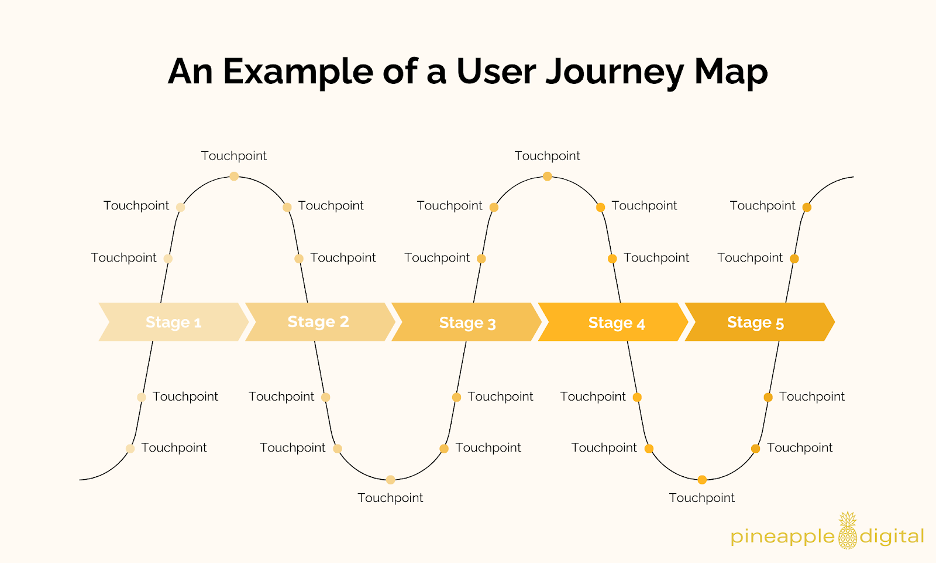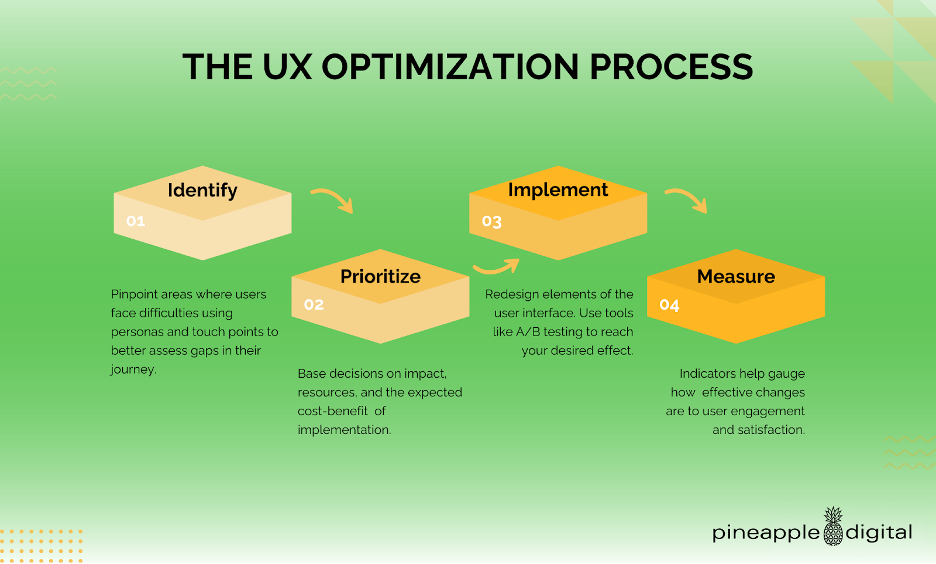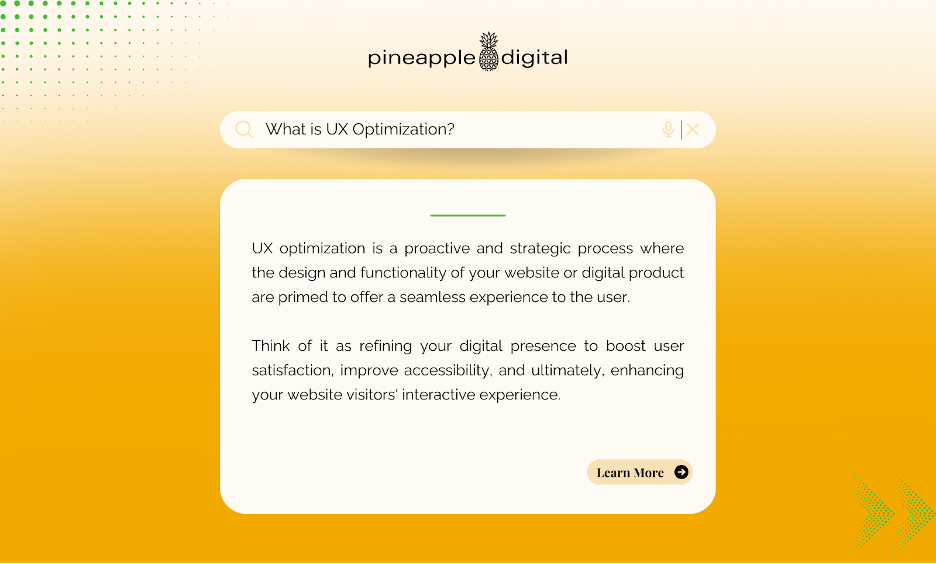UX Optimization: What It Is and Why You Need It
Ever feel like your online efforts are falling flat? User Experience, or UX, optimization might be the game-changer you’ve been looking for. Say goodbye to digital headaches and hello to a smoother, more successful online experience.
As people become more familiar with technology, they begin to expect improved experiences and never backslide into the days of constant interruption or lagging pages. This makes a user-friendly and responsive online presence invaluable. But what exactly does UX optimization mean?
Simply put, UX optimization is a proactive and strategic process where the design and functionality of your website or digital product are primed to offer a seamless experience to the user. Think of it as refining your digital presence to boost user satisfaction, improve accessibility, and ultimately, enhance the user’s interactive experience.
The main focuses are making your website look visually appealing and ensuring that the elements you include serve a purpose and contribute to delivering value to the end user. From making the web page layout more intuitive, and perfecting user interface and navigation, to fine-tuning the landing page, UX optimization casts a wide net over many facets of any digital platform.
The Necessity of UX Optimization

Let’s consider a typical user’s journey on a business’s website:
- They land on the homepage.
- Then, they browse through various product categories and choose a product or service that interests them.
- After some scrolling and research, the user likely adds it to their cart or submits a contact request.
- This entire journey needs to be smooth, intuitive, and hassle-free.
- If users encounter difficulty at any stage, they are likely to abandon their journey midway. UX optimization steps in by streamlining the user journey and making it as effortless as possible.
Optimizing for Ease of Use
An optimized user experience can help forge your path to success. A digital product that is easy to navigate and adds value for the user is likely to garner higher user satisfaction, positive reviews, and best of all, conversions. This can lead to more positive reviews and increase your product’s reach to a wider potential customer base.
There are some things to consider that have a significant effect on user experience and can contribute greatly towards user satisfaction and customer retention, these include:
- A well-structured and convenient layout
- Easy-to-understand graphics
- Responsive design staging
- Clear Calls-to-Action
Beyond the User: Optimizing for Visibility
Every search engine has an algorithm. These algorithms are becoming more sensitive to user experience. They reward websites with better user interfaces and improved user experiences with higher search rankings and improved visibility. If users frequently leave your website shortly after arriving, search engines interpret this as a signal that your site does not provide the information or experience that users were hoping for. By improving the user experience, UX optimization can indirectly help boost your website’s rankings in search results.
The Mobile-First Approach
The shift towards mobile usage has necessitated a mobile-first design philosophy, where the primary user interface and experience are crafted for mobile devices before being adapted for desktops or tablets. In 2023, SEMrush reported there were 313% more visits on mobile compared to desktop. Prioritizing mobile UX Optimization is essential as mobile increasingly becomes the primary means of internet access for users globally, offering significant benefits like increased reach and engagement.
Ongoing Performance Reviews
Since the online landscape is constantly evolving, keeping your website optimized to the user’s changing preferences and needs is a MUST. The behavior of your audience can fluctuate due to various factors, like new technological developments or changing market trends. Only by continuously fine-tuning your website’s user experience in line with these shifts can you ensure a consistent, superior user experience for your audience.
UX optimization is not just a one-time task. It’s an ongoing process that helps you keep up with changing user expectations and achieve an engaging, mobile-friendly website your audience loves—ultimately resulting in higher conversion rates, attainment of business objectives, and sustainable success online.

The Process of UX Optimization
To understand the flow and efficiency of UX optimization, it’s crucial to understand the processes that go into achieving results. Here’s a detailed breakdown of the most essential steps involved in creating a user-centric and optimized website or digital product.
Step 1: Identifying UX Issues
Identifying UX issues is the first step in the optimization process. Techniques such as usability testing and analyzing user behavior data are instrumental in pinpointing areas where users face difficulties.
Step 2: Prioritizing UX Changes
Once issues are identified, prioritizing UX changes is crucial. Decisions should be based on the potential impact, the resources required, and the expected cost-benefit ratio of implementing these changes.
Step 3: Implementing and Testing UX Changes
Implementing UX changes involves redesigning elements of the user interface and interaction. These changes should be rigorously tested through methods like A/B testing and user acceptance testing to ensure they achieve the desired effect.
Step 4: Measuring UX Optimization Efforts
Traffic comes from SEO, paid media, and other sources, while conversions can be any key performance indicator (KPI) that matters to your business. Indicators, like bounce rate or engagements, help gauge the effectiveness of the changes in enhancing user engagement and satisfaction.
Bridging the importance of UX to the bottom line of your online presence involves attention to ‘conversion rates’. With ‘Conversion Rate Optimization (CRO)‘, you can use user testing to analyze the behavior of visitors and focus on what motivates a particular group’s actions. It’s about optimizing your website or landing page for better quality traffic and more conversions, not just high numbers of website visitors.
Best Practices for a Positive User Experience
Maintaining a positive user experience is crucial. Best practices include ensuring intuitive design, clear communication, and responsive layouts that adapt seamlessly across devices.
Usability Testing
At the center of UX optimization lies Usability Testing, a process where a website or digital product is tested by real users to keep a check on its usability and effectiveness. Usability testing can include a variety of techniques, ranging from face-to-face interviews to remote user testing. These tests provide UX designers with valuable insights into hurdles that may sour user satisfaction.
Role of the UX Designer
A UX Designer plays an instrumental role in taking the website or digital product from a basic framework to a fully functional and optimized platform. The UX Designer primarily focuses on user research, usability tests, creating intuitive user interfaces and eventually carrying out user experience design. Through every step, the designer’s focus remains on prioritizing the user’s needs to make the overall experience seamless and enjoyable.
Integrating A/B Testing
A/B testing is an essential tool in the UX optimization toolbox. Also known as split testing, A/B testing enables UX optimizers to experiment with different versions of a web page, interface, or feature to determine which one performs better. It’s all about comparison and results in an optimization strategy that’s rooted in actual user data.
Utilizing Heatmaps
Heatmaps show where users click, how far they scroll, and which parts of the page grab their attention the most. These insights are crucial for identifying areas that are working well and those that need improvement. By analyzing heatmaps, UX designers can make informed decisions on layout adjustments, content placement, and call-to-action optimization to enhance overall user engagement.
Leveraging Google Analytics
Another significant resource in the UX optimization process is Google Analytics. GA4 helps track and report website traffic and provides a wealth of data on user behavior on your website. This data—ranging from bounce rate to time spent on individual pages to conversions—can be used strategically to focus your optimization efforts.
As you navigate your way through these set steps, a UX-optimized website or digital product begins to take form—promising elevated user satisfaction, the potential increase in conversion rate, and lasting success in the digital space.
Pineapple Digital Is the Solution You’ve Been Looking For
At Pineapple Digital, we understand that UX optimization is not a one-size-fits-all process. It requires a tailored approach, keeping in mind the unique needs of your business and target audience. Leveraging our rich experience in creating optimized digital solutions, we are well-equipped to deliver a comprehensive strategy.
Our methods blend creative problem-solving, technical expertise, content creation, and data-driven decisions. We aspire to partner with you in this journey, offering an optimized, customer-centric approach that translates into tangible results. Let’s create a remarkable online presence together! Contact us today to get started.
